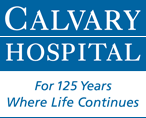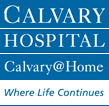Dear Calvary,
For the past two years, I have been administering my brother’s and sister’s estates. As trustee, I have been pleased to be able to send the hospital donations from Vincent Accardi’s, Mary Damiano’s trusts. While I have fulfilled my financial responsibility to siblings, I feel I owe it to them to tell you a bit about our family and the lives that produced these special gifts to Calvary.
Our parents were born in Santa Ninfa, a small town near Palermo, Sicily; they came to the United States as children. They grew up in Brooklyn, met and married, and in 1908 when my brother Vincent was one and a half years old, they decided to return to Italy. In addition to owning and operating two barbershops, my father was very knowledgeable about medical matters. He would frequently accompany the town’s Medico Condotto (county doctor) assisting him when he made house calls to see patients too ill to travel into town for an office visit. I guess my brother Vincent must have inherited his talent for medicine from my father.
…THE HOSPITAL’S REPUTATION AS A NATIONAL MODEL FOR PALLIATIVE CARE APPEALED TO MY SENSIBILITIES AS AN EDUCATOR. IT SEEMED NATURAL TO LEAVE LEGACIES TO A CAUSE THAT EMBODIED OUR PROFESSIONS AND OUR PASSIONS.
While they were in Italy, each year my father would renew the family’s American citizenship papers, with the hope of returning someday. In 1924 he returned to New York. We stayed in Italy with my mother for one more year, waiting for my father to get reestablished. That’s the way things were done back then.
My brother had been an exceptional student in Italy and he received a military scholarship to the elite Royal Naval Academy in Livorno. His academic career took a different direction here in America. He pursued undergraduate and master’s degrees in Biology at St. John’s College (now St. John’s University) and then studied medicine in Chicago, at Loyola Medical School and the University of Chicago’s Rush Medical School. When he finished his internship at Kings County Hospital in Brooklyn, it was the height of the depression, and Vincent decided to work for the government. The Department of Interior placed him with an Indian Reservation in New Mexico. Originally he intended to stay for just one year, but he opened up a medical practice in Gallup, New Mexico where he treated patients for over 50 years. He treated the poorest and the richest folks in town; a person’s finances made no impression on him. Recently, I was going through some of his papers and came across a bill for an office visit. I was amused to see the charge was only $2.00!
In 1942, Vincent told my sister Mary about a job opportunity near Gallup, N.M.; this launched her career in government. Mary had studied at Hunter College for a couple of years and after completing a legal secretary program, she was doing paralegal work for a group of lawyers on Court Street in Brooklyn. She moved west to begin working as a secretary to the chief engineer at the Wingate Ordnance Depot. Returning to Brooklyn in 1944 to join the Overseas Supply Agency, Mary rose through the ranks as the organization expanded. In 1968 she was appointed Chief of the Quality Control Division for the Eastern Area Military Traffic Management and Terminal Service (EAMTMTS). She was charged with the duty of managing the computer data crucial to the operation of military ocean terminals, passenger and cargo movements throughout the Eastern and Midwestern regions of the United States, and payrolls for contractor, civilian and military personnel. In a federal division dominated by men, she was one of only three women to have ascended to the level of Chief in the EAMTMTS and broken through what was then referred to as the “grey flannel suit barrier.”
Vincent was the oldest and our only brother. I had 3 sisters: Ann, a fashion designer who died at age 64; Tina, a medical secretary who died at the age of 47; and Mary, who passed away recently at the age of 88. I was the baby of the family. We were a very close family and liked spending time together. We also shared information on investment opportunities and discussed plans for the future.
At my suggestion, Vincent and Mary both decided to include provisions for Calvary in their trusts. I made my first contribution to Calvary in 1953. A family friend suffering from a form of brain cancer was treated at the House of Calvary (as it was called in those days.) The family had no resources and Calvary was the only place that would admit him. I was impressed with the way Calvary embraced this family and didn’t leave him alone in his time of need.
We have a history of cancer in our family and this prompted me to make a number of gifts to Calvary throughout the years. When I retired from my career as a professor of chemistry and prepared my estate plans, I included a charitable provision for Calvary and became a member of The Society of 1899. I was pleased that Vincent and Mary followed suit. Calvary’s ability to deliver special medical services matched Vincent’s background as a doctor; the hospital’s community involvement corresponded nicely with Mary’s work in government; and the hospital’s reputation as a national model for palliative care appealed to my sensibilities as an educator. It seemed natural to leave legacies to a cause that embodied our professions and our passions.
I had always believed in the importance of end of life care, but I saw the value of it first-hand as the primary caregiver for Vincent, who spent his final 18 months in hospice. A lot of places focus on the research and curative treatments and while there is certainly a need for those too, it is a comfort to know there is a special place like Calvary that helps patients and families with the transition that happens at the end of life.
Sincerely yours,
Rose H. Accardi
Categories
Archives
- June 2025
- May 2025
- April 2025
- March 2025
- February 2025
- October 2024
- August 2024
- July 2024
- May 2024
- April 2024
- March 2024
- February 2024
- December 2023
- November 2023
- October 2023
- August 2023
- July 2023
- June 2023
- May 2023
- April 2023
- March 2023
- January 2023
- December 2022
- October 2022
- August 2022
- July 2022
- June 2022
- April 2022
- March 2022
- February 2022
- January 2022
- October 2021
- September 2021
- August 2021
- July 2021
- June 2021
- May 2021
- April 2021
- March 2021
- February 2021
- December 2020
- November 2020
- October 2020
- September 2020
- August 2020
- July 2020
- May 2020
- April 2020
- March 2020
- February 2020
- January 2020
- December 2019
- November 2019
- October 2019
- September 2019
- August 2019
- July 2019
- May 2019
- April 2019
- March 2019
- February 2019
- January 2019
- December 2018
- November 2018
- October 2018
- September 2018
- August 2018
- July 2018
- June 2018
- May 2018
- April 2018
- December 2017
- November 2017
- October 2017
- September 2017
- August 2017
- July 2017
- June 2017
- May 2017
- April 2017
- April 2012

